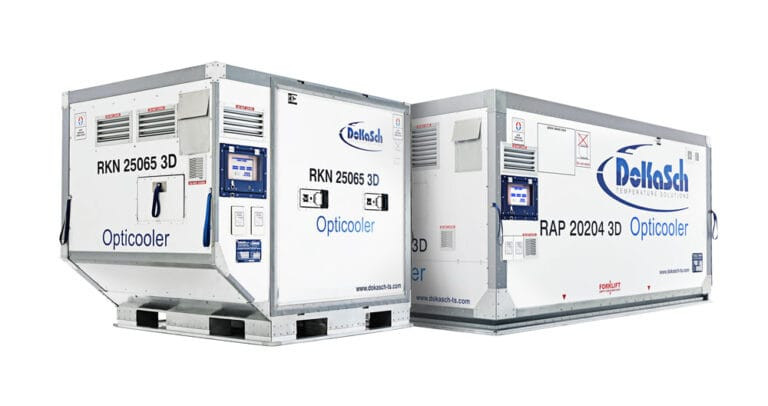- Active temperature-controlled containers (Envirotainer, CSafe, DoKaSch, SkyCell, Swiss Airtainer) form a specialised pharma air cargo niche, critical for biologics, cell-and-gene therapies, and GDP-compliant cold chain logistics.
- DoKaSch Temperature Solutions expanded its U.S. network with a new Atlanta service station (May 2025), boosting Opticooler availability near Southeast life science clusters and cutting lead times for pharma manufacturers.
- Swiss Airtainer’s SAT RKN, the lightest solar-assisted active container, was approved by Delta Cargo in Dec 2024 – the first U.S. airline adoption, signalling broader acceptance of next-gen lightweight ULDs.
- Innovation trends include frozen set-points for biologics, lightweight solar-assisted RKNs, and solutions reducing empty container returns, improving resilience, cost efficiency, and sustainability across pharma lanes.
- The active ULD segment, though smaller than the $13.8bn global temperature-controlled packaging market, is strategically vital, with growth driven by biologics pipelines, clinical trials, and demand for high-reliability air freight.
The active container niche is a specialised, high-reliability segment of air cargo built around biopharma’s exacting needs. The competitive field is concentrated – Envirotainer, CSafe, DoKaSch, SkyCell with Swiss Airtainer emerging – and procurement decisions hinge on lane coverage, station density, set-point needs and sustainability goals. The market’s value is small relative to wider cold-chain packaging, yet it is strategically important and growing with biologics and cell-and-gene pipelines. Over the last 18 months, the most material developments have been frozen set-points, lightweight solar-assisted RKNs and operating innovations that address empty returns – all of which improve resilience and cost on global pharma lanes.
A recent development has seen DoKaSch Temperature Solutions expanding its US presence with new service station in Atlanta. DoKaSch Temperature Solutions, a specialist in active temperature-controlled containers for the global air cargo industry, opened the station in collaboration with SEKO Logistics. The station commenced operations in May 2025.
The new service station near Hartsfield–Jackson Atlanta International Airport, expands DoKaSch’s US and global network for time-critical pharmaceutical logistics. Positioned close to key life science clusters in the Southeast, including Raleigh–Durham, it ensures a high availability of Opticoolers for immediate deployment. This proximity allows pharmaceutical manufacturers and forwarders to access temperature-controlled containers at short notice, reducing lead times and ensuring the integrity of temperature-sensitive pharmaceuticals throughout global transport. The strategic location supports fast, reliable and sustainable cold chain solutions, enabling rapid deliveries to key markets across the Americas and worldwide.
“The launch of our new station in Atlanta is a strategic move to strengthen our network in the US and provide quicker access to our Opticoolers in a key logistics region,” said Andreas Seitz, managing director of DoKaSch Temperature Solutions. “By positioning containers closer to our customers, we support their operations with enhanced reliability and responsiveness.”
Meanwhile, Swiss Airtainer, provider of the lightest and most technologically advanced active RKN, in December 2024 announced that Delta Cargo had approved the SAT RKN under their Specialized Pharma – Approved Containers product. Delta Cargo is the first US-based passenger airline to approve the SAT RKN.
Active temperature-controlled containers
Active containers are self-powered ULDs with integrated heating and cooling, typically set to +2 to +8°C, +15 to +25°C or, increasingly, sub-zero set points for frozen biologics. They rely on rechargeable batteries, compressor-driven HVAC and precise control systems, with many models now offering real-time telematics for lane visibility. Standard form factors are RKN (single-pallet footprint) and RAP (multi-pallet). Airlines approve specific manufacturers’ units and make them available on lease through pharma products and stations worldwide.
Passive shippers use phase-change materials and insulation without power; they dominate parcel and some bulk lanes. Active containers, by contrast, are chosen for tight temperature control over long sectors, variable ambient conditions, high-value payloads and when re-icing or lane conditioning is impractical. Airlines position and maintain active fleets at network stations, and shippers book them much like ULDs via forwarders. Carriers’ pharma products explicitly reference active units from the market’s leading brands.
The wider temperature-controlled packaging market across modes (active and passive, parcel and bulk) is much larger – $13.1bn in 2024, $13.8bn in 2025 – but most of that value sits outside powered air ULDs.
Given those anchor points, interviews and fleet disclosures imply the active air-ULD niche sits in the low hundreds of millions of dollars per year, driven primarily by biopharma and clinical supply chains, with growth underpinned by biologics pipelines and stricter GDP compliance.





